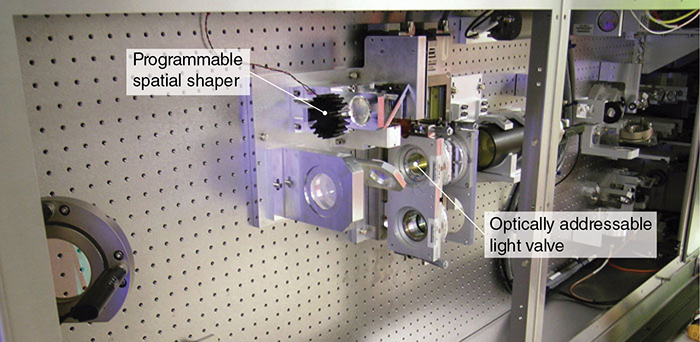More Shots, More Potential for Success
March 6, 2024
 The programmable spatial shapers package incorporates optically addressible light valves to extend the operational lifetime of the National Ignition Facility’s high-energy laser optics by obscuring laser light where flaws exist in optical components, limiting further damage during subsequent shots.
The programmable spatial shapers package incorporates optically addressible light valves to extend the operational lifetime of the National Ignition Facility’s high-energy laser optics by obscuring laser light where flaws exist in optical components, limiting further damage during subsequent shots. The following is an excerpt from an article by Suzanne Storar in the December 2023 issue of Science & Technology Review:
LLNL’s National Ignition Facility (NIF) stands to gain from a Laboratory Directed Research and Development (LDRD) project to explore ultrawide bandgap (UWBG) photoconductive devices.
NIF, the world’s highest-energy laser system, simulates extreme temperature and pressure conditions to advance understanding of fusion ignition and thermonuclear burn, relevant to stockpile stewardship.
Programmable spatial shapers (PSSs) at NIF modulate laser intensity in the optical beam path to address laser-induced damage on optical components, which increases shots per year by reducing maintenance time and costs. Optically addressable light valves (OALVs) with wide bandgap bismuth silicon oxide (BSO) as a photoconductive layer enable drop-in retrofit of NIF’s PSS system.
“The PSS is a critical component for preventing degradation of downstream optical elements under laser illumination,” said engineer Sara Harrison, a member of the LDRD project team. “The practice is to block light from shining in areas where flaws exist in the optics. While this protects the optics, light is thrown away unnecessarily with the present configuration. Therefore, NIF is eager to improve PSS specifications by exploring materials that enable the position of the OALVs to be shifted in the beam lines.”
To read the full story and a more in-depth article on ultrawide bandgap semiconductor materials, go to Science & Technology Review
—Suzanne Storar
Follow us on Twitter: @lasers_llnl



